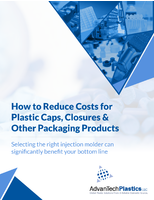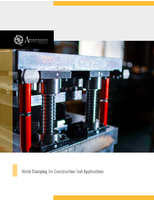Laser-Sintering Facilitates Bionic Gripper Manufacture

German industrial control and automation company, Festo, a world leading supplier of pneumatically- and electrically-actuated automation systems, is using additive manufacturing (AM) to produce a bionic gripper that can pick up and put down objects flexibly, reliably, gently and safely. Fast and economical batch production of the complex components at the company's Esslingen factory is achieved using a FORMIGA P 100 plastic laser-sintering machine from EOS.
The advantages over conventional manufacturing practices are many. Due to the design freedom afforded by layer-by-layer AM, the number of individual parts has been reduced, making assembly less costly. As injection mould tools are not needed, further time and cost savings result. The weight of the gripper is lower, as it can be made from polyamide instead of metal, which is an advantage in some applications.
The so-called Bionic Handling Assistant was awarded the 2010 Deutscher Zukunftspreis, a technology and innovation award endowed annually by the German Federal President. Unlike conventional industrial robots, the pneumatically controlled unit has the particular benefit that direct contact with people is not hazardous, as in the event of a collision the system yields immediately. The design allows for smooth movement, with 11 degrees of freedom and an unparalleled weight / payload ratio.
Festo has been gathering experience with AM since 1995. What began with concept models and functional prototypes has developed into the manufacture of several thousands of parts per year.
Products derived from nature are often of complex design. The flexible bionic handling assistance system is based on an elephant's trunk and consists of three elements for spatial movement. At the end is a 'hand', called a DHDG adaptive gripper, modelled on a fish fin.
Klaus Müller-Lohmeier, head of advanced prototyping technology at Festo AG, said, "The gripper's functionality and structure, incorporating components of complex geometry, makes it impossible to produce the product by any means other than AM.
"Just four components produced in a FORMIGA P100 are sufficient to make a complete Bionic Handling Assistant.
"Thanks to the design freedom that laser-sintering gives us, we can manufacture movable, flexible but also specifically rigid shapes, just as they occur in nature.
"Our designers can operate independently of the restrictions of conventional manufacturing techniques and concentrate fully on the implementation of the natural principles they have analysed.
"We are using laser-sintering more and more for projects in which limited annual quantities of a complex part are required. In these cases, the process is a real alternative to existing, often tool-based methods."
The fish fin-inspired DHDG adaptive gripper is now integrated into Festo's product range and is already used by customers all over the world. Its structure may be adapted for a user's specific application. The gripper fingers adjust precisely to the contour of a workpiece and even sensitive objects or those of complex shape can be gripped and moved safely.
Noteworthy is that the gripper elements have their final functionality immediately after laser-sintering, without the need for expensive assembly. Accordingly, laser-sintering is a manufacturing precondition. Festo says that there is no practical alternative.
Moreover, the DHDG adaptive gripper is 80 per cent lighter than conventional grippers made of metal. The fact that plastic is able to replace metal is due to the ability of the laser-sintering process to produce lightweight, elastic yet very strong structures. Studies have shown that the gripper elements can withstand more than five million bending cycles.
Müller-Lohmeier concluded by mentioning that tool-less production with AM is especially cost-efficient. In an unrelated customer project, Festo manufactured 12,000 components by laser-sintering as an alternative technology, saving 40 per cent of the unit cost compared with injection moulding.
All parts were finished within one week in just four build cycles, whereas conventional production would have taken two months. The company was therefore able to launch the product much faster.
Videos of the Bionic Handling Assistant in action can be seen at:
http://www.youtube.com/watch?v=SKJybDb1dz0
and
http://www.youtube.com/watch?v=EeSUPTAz2MM
EOS was founded in 1989 and is today the world's leading manufacturer of laser-sintering systems. Laser-sintering is the key technology for e-Manufacturing, the fast, flexible and cost effective production of products, patterns and tools. The technology manufactures parts for every phase of the product life cycle, directly from electronic data. Laser-sintering accelerates product development and optimises production processes. EOS completed its business year 2009/2010 with revenues of 64 million Euros. The company employs 300 people worldwide, 250 of them in Krailling near Munich, Germany. For more information visit www.eos.info
On behalf of:
EOS Electro Optical Systems Ltd,
The Innovation Centre, Warwick Technology Park,
Gallows Hill, Warwick, CV34 6UW.
Tel: 01926 623107. Fax: 01926 623108.
E-mail: stuart.jackson@eos.info
Web site: www.eos.info
Contact: Stuart Jackson, Regional Manager, UK & Eire.




